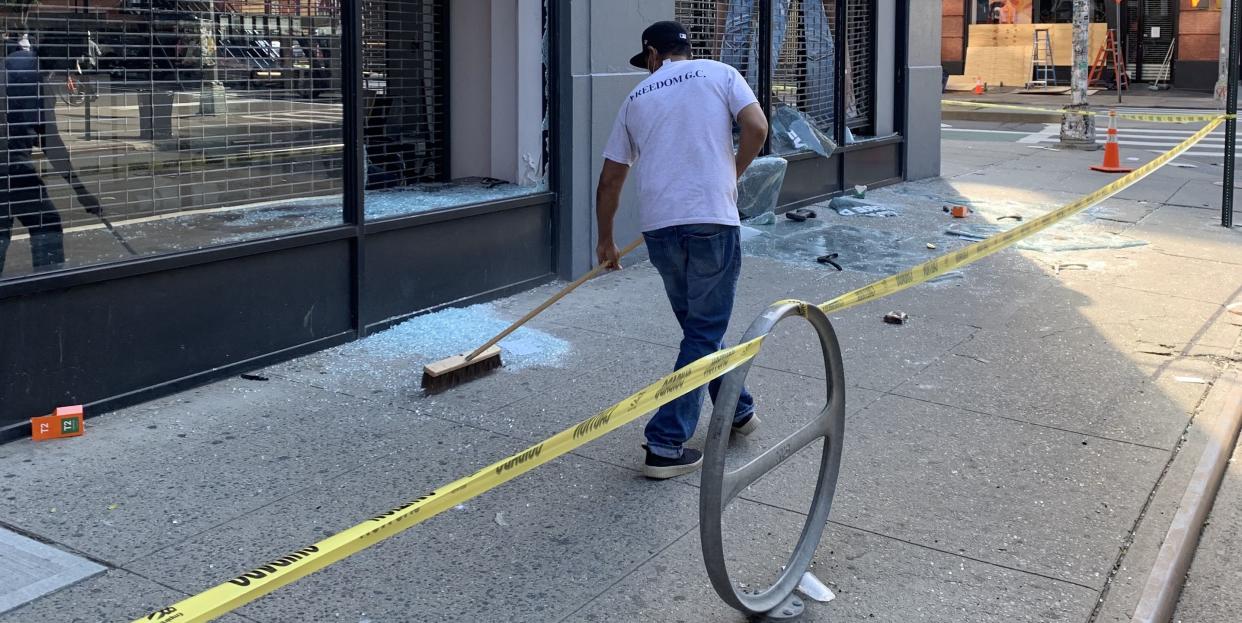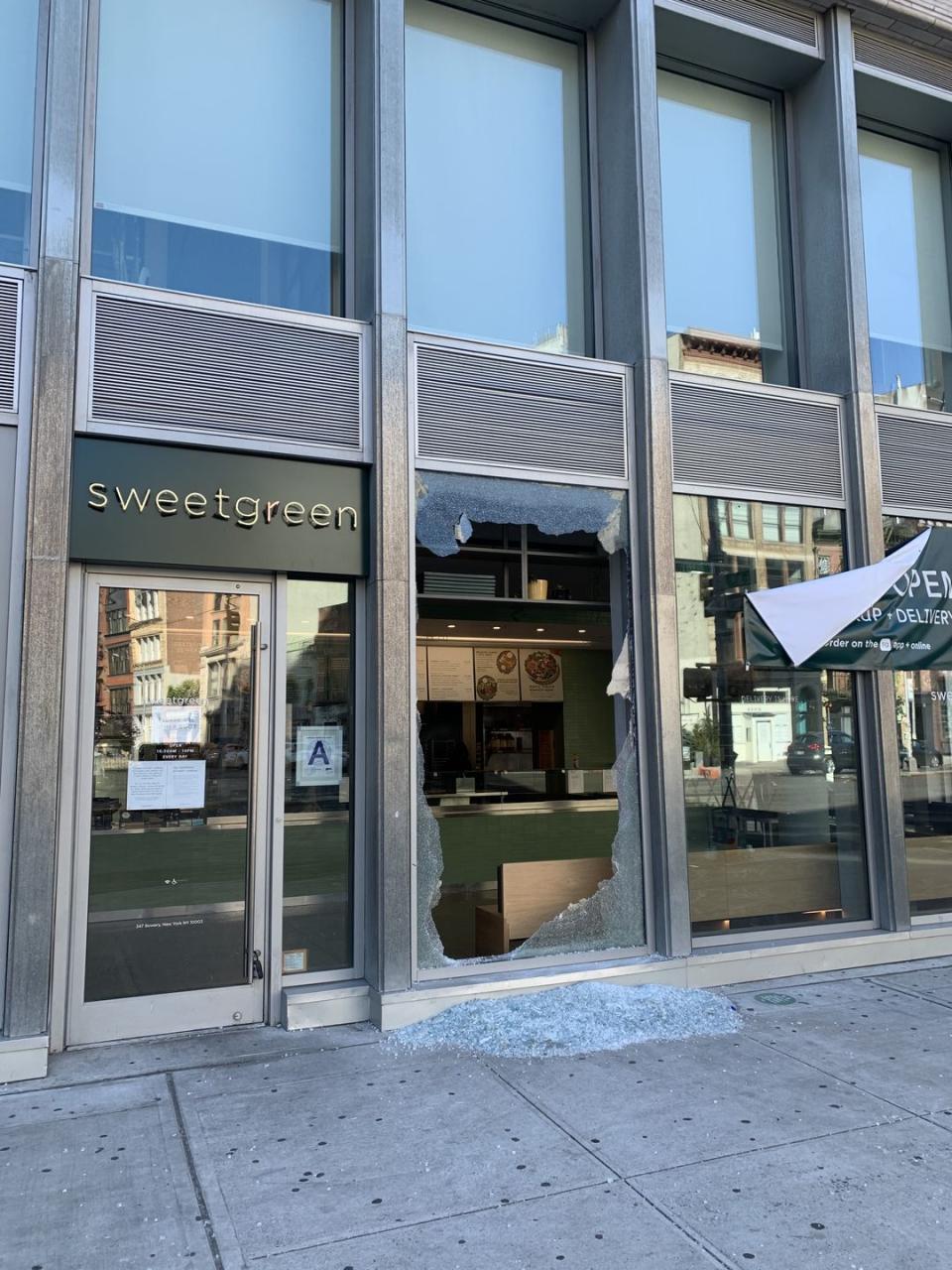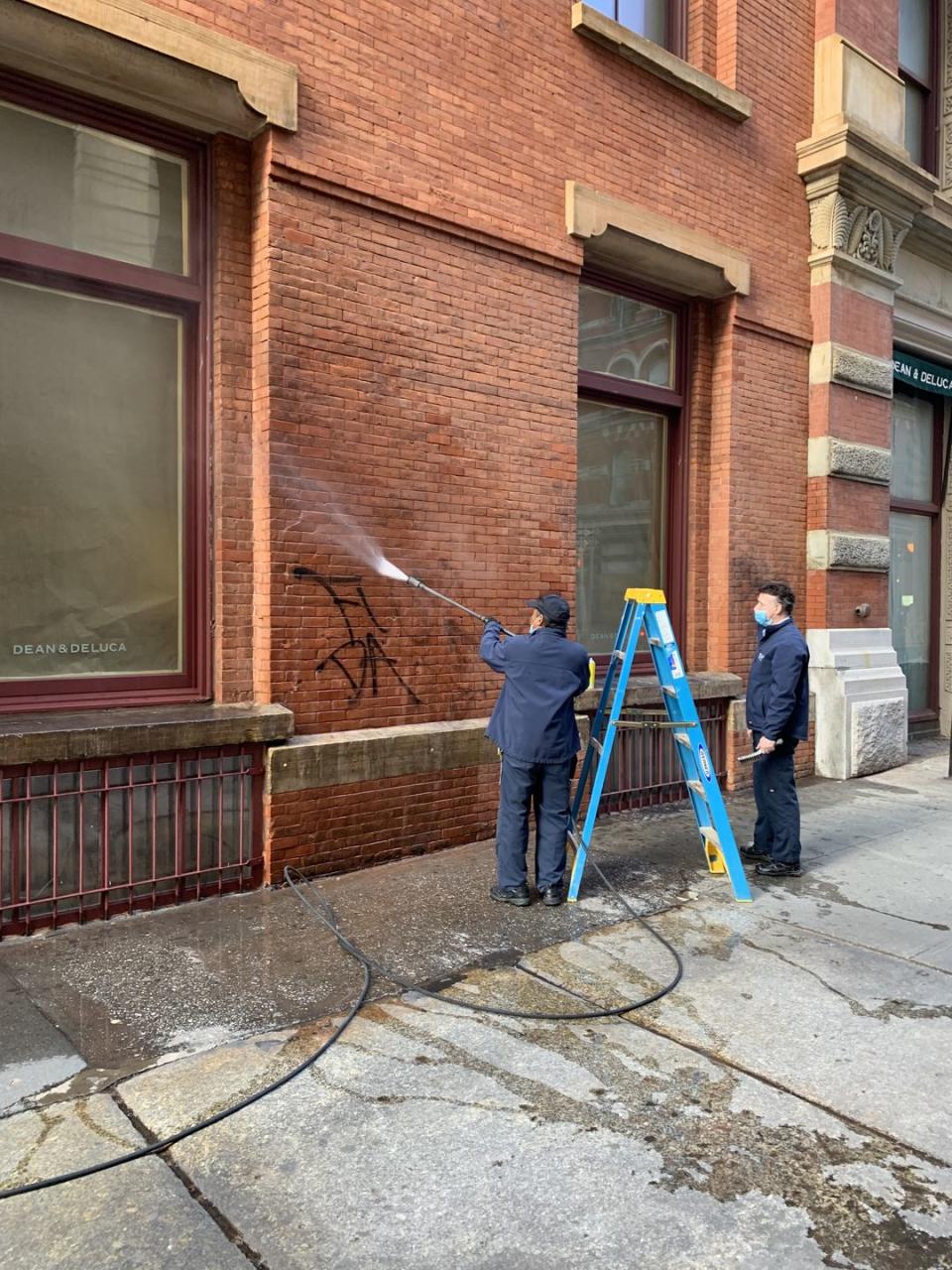Someone Does Have to Clean It Up

NEW YORK—"It's the morning after a storm," said Keith Williams as he shoveled packages from the back of his UPS truck on Bleecker Street.
It was around 9:30 Monday following a weekend of massive social unrest in New York and across the country, as many thousands raised their voices in outrage at the killing of George Floyd by Minneapolis police a week earlier, the latest high-profile incident of police violence that showcased the unequal application of force and the law in this country. Friday evening in the nation's largest city saw spontaneous protests centered at Union Square and the Barclays Center, the latter of which spiraled as the NYPD, attempting crowd control, turned to violent aggression against protesters. It was a harbinger of things to come in a number of cities, as far too often police turned to tear gas and rubber bullets rather than seeking to deescalate situations and safeguard the rights of citizens to assemble peacefully to demand a redress of grievances.
On Saturday, the afternoon saw peaceful marches in Manhattan and Brooklyn, as protesters shut down streets for short periods of time and NYPD officers walked alongside them. On Second Avenue, cars and buses honked in solidarity with the marchers, who chanted together as they walked slowly and with purpose. But as a crisp day on the cusp of summer turned to dusk, what had been a march for liberation became, in some quarters, something else. Police use of force began to escalate. When night fell, many in the streets continued to assemble peacefully, but a smaller number began breaking things. Store windows on Second Avenue were smashed. The pattern largely repeated itself on Sunday: peace in the daylight gave way to pockets of chaos at night.

The destruction of property is nothing compared to the destruction of human life, but somebody still has to clean up afterwards. Not far from where Keith Williams was delivering packages, a 7/11 on the Bowery had been smashed and looted. Next door, a man stepped calmly through the shattered window of a Sweetgreen and out onto the sidewalk. He said his name was Horatio, and he was the store operator. (Many people I spoke to did not give more than a first name, as they were on the job.) The security company had called him at about 10:30 or 11 p.m. Sunday night to say the alarm was going off, and to ask if he wanted to call the police. He told them yes.
"At night," he said, "it seems like people just want to lash out." He watched the surveillance video this morning, and nobody had gone inside as they had next door. They just smashed the window. A man who lives around here told Horatio he'd tried to stop it. There are a number of facilities nearby, like the Bowery Mission, providing help to those who most need it. "We try to help out, too," Horatio said, implying that at least some of his store's extra food does not go to waste, and that folks in the neighborhood appreciate that. "It's just unfortunate," he said, pressing his key into the door.
On Prince Street, in the heart of Soho, two men, Robert and Walker, were going to work on some black spray paint. With a can of "Goof Off" graffiti-removal spray and a power-washer, they'd reduced one of the many tags on the red brick to "FU." I asked them whether this was their only building they'd be working on. "Oh, yeah," said Robert. "I'd be in trouble otherwise." Graffiti covered buildings up and down the tony shopping district, and there were plenty of smashed windows. Some stores were looted, but often, as at Sweetgreen, it seems people just wanted to leave a mark. One store on Broadway, the main retail drag, had been covered over with plywood painted in cheerful colors, perhaps months ago when the store was shuttered during the pandemic. The mural facade was now punctured: "Fuck NYPD," read two messages in two different paints.
"Ideally, you'd want to hire a company who's got the special chemicals" to deal with spray paint, Robert said. "But I gotta do something now." A couple of guys came by rolling a massive city trash can, one of the big metal cylinders that normally sits on each street corner. They teased Walker, who stood back while it was Robert's turn to get in there with the power-washer. "He don't wanna work!" Robert called back, chuckling. Up and down Bowery and Broadway, very few cans remained in place. You could walk for blocks without seeing one. I asked how many they'd moved already this morning. "Not many," said one, who wheeled along before I could get his name. "We just started."

Often, the people cleaning up here did not seem particularly upset at what happened, or what they now had to do. "Good for business!" said Simon, a contractor sweeping up shattered glass outside G-Star on Prince and Lafayette, and he was only mostly joking. Almost everyone I spoke with was black or Latino, because that's who often does these jobs—the ones we lately have decided are "essential," the ones you have to show up every day to do, even in the age of pandemic disease. They will bear the brunt of this now, sweeping glass and removing graffiti and boarding up windows with plywood. There may well be a repeat tomorrow. But they also bear the brunt of the relentless forces of American inequality at the root of all this.
"Fucking idiots who aren't even from this neighborhood fucking shit up!" shouted a biker who rolled by on Broadway. But that's kind of the point, isn't it? Manhattan, where these fabulous stores are and where most of the people who can afford to shop in them live, has largely been spared the worst of the coronavirus outbreak. Many of the wealthy locals fled town months ago, bound for vacation homes. Neighborhoods where poorer people, racial minorities, and the historically disadvantaged live have been hardest hit.

Black Americans are not just disproportionately likely to be killed by police in this country. They also have less access to healthcare and other services. They're more likely to be living paycheck to paycheck, taking the choice out of it when it comes to going to work when you're sick or afraid of getting sick. They're more likely to die of COVID-19. In front of a funeral home on Second Avenue, a refrigerator truck has been parked outside for weeks to help deal with the unusual number of bodies. By Monday morning, it also had graffiti. "Dear NYPD," it read, "This is the cost." Except "cost" had been crossed out, replaced below in different scrawl with "just the beginning." These truths around who suffers and dies in this country have been with us forever, and the only time people in Soho, or the Village, or the Upper East Side seem to take notice is when the turmoil bleeds into their neighborhoods.
"If you just walk by me, you can brush me off," said Keith Williams from the back of his UPS truck. "But if I bark at you, it might shake you"—he seized up his shoulders as if a car had backfired behind him—"and then you might start thinking something is wrong."
And that's a bit of what Williams was getting at on Monday morning. Knowingly or not, he channeled Dr. King's wisdom that "a riot is the language of the unheard." It's still unclear who exactly is breaking windows in New York. (Elsewhere, there's disturbing evidence that it may not always be antiracist protesters vandalizing stores or instigating violence.) But stepping down from the truck, Williams said that he and his 19-year-old daughter had to have "that conversation" with his 12-year-old son this week, not least because of the images rolling through constantly on television and social media. "What are you gonna do if you run into the cops?" he says he asked, a conversation few white American parents have to grapple with. Williams says black parents shouldn't have to prepare their children for this system any longer. What black Americans are demanding is that the state honor its end of the social contract.
How many times can human beings tell these stories, only to be ignored, before they feel like setting something on fire is the only way to keep someone's attention? How long can they watch an NFL player engaged in peaceful protest be ridiculed as an enemy of the state before all that talk of peaceful protest rings hollow, and the thought of smashing a window garners for itself a certain degree of logic? And still, in the end, someone has to sweep away the shards of glass.
You Might Also Like


